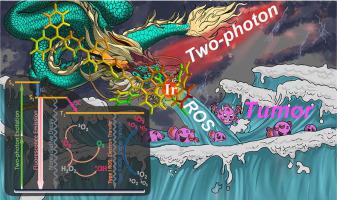Chemical Engineering Journal ( IF 15.1 ) Pub Date : 2022-06-23 , DOI: 10.1016/j.cej.2022.137604 Yihang Jiang , Wei Zhu , Zhourui Xu , Zhijun Zhang , Shuo Tang , Miaozhuang Fan , Zhengzheng Li , Jianyu Zhang , Chengbin Yang , Wing-Cheung Law , Ken-Tye Yong , Dong Wang , Gaixia Xu , Ben Zhong Tang

|
In recent years, two-photon photodynamic therapy (TP-PDT) has received extensive attention in cancer treatment owing to its unique advantages of deep tissue penetration and high spatial-temporal controls. However, the high oxygen dependency of photosensitizers still remained as the major obstacle which undermined its overall therapeutic efficacy, especially in hypoxic-tolerant tumors. Exploration of new TP-PDT strategy with less-oxygen-dependency and subcellular organelle-targeting ability is an appealing yet seriously challenging task. In this work, a mitochondrion-targeting TP-PDT protocol based on type-I PSs with aggregation-induced emission (AIE) characteristics is proposed for the first time. Of the two synthesized AIE-active PSs, TPABP-Ir is demonstrated superior reactive oxygen species (ROS) production (both type I&II) owing to the doping of Ir(III). After encapsulation into bovine serum albumin (BSA) matrix, TPABP-Ir@BSA nanoparticles (Ir-NPs) are capable of realizing mitochondrion-targeting, high ROS production, and suppression of tumor growth under 880 nm femtosecond laser excitation. This study provides a novel treatment strategy which maximizes the PDT efficacy and offers a conceptual but practical paradigm for cancer treatment in translational nanomedicine.
中文翻译:

一种具有聚集诱导发射特性的线粒体靶向双光子光敏剂,用于耐缺氧光动力治疗
近年来,双光子光动力疗法(TP-PDT)以其独特的深层组织穿透和高时空控制优势在癌症治疗中受到广泛关注。然而,光敏剂的高氧依赖性仍然是破坏其整体治疗功效的主要障碍,尤其是在耐缺氧肿瘤中。探索具有较少氧依赖性和亚细胞细胞器靶向能力的新 TP-PDT 策略是一项有吸引力但极具挑战性的任务。在这项工作中,首次提出了一种基于具有聚集诱导发射(AIE)特性的I型PSs的线粒体靶向TP-PDT协议。在两种合成的具有 AIE 活性的 PS 中,TPABP-Ir 被证明具有优异的活性氧 (ROS) 产量(I 型和 II) 由于 Ir(III) 的掺杂。TPABP-Ir@BSA纳米粒子(Ir-NPs)包裹入牛血清白蛋白(BSA)基质后,能够在880 nm飞秒激光激发下实现线粒体靶向、高活性氧产生和抑制肿瘤生长。本研究提供了一种新的治疗策略,可最大限度地提高 PDT 疗效,并为转化纳米医学中的癌症治疗提供概念但实用的范例。



























 京公网安备 11010802027423号
京公网安备 11010802027423号